
Midway - Hidden in Plain Sight
(written by Scott Brouwer, Archives staff; “Charleston” information from Bill Petersen, former Archives staff)
Traveling north on Hwy. 35 between Onalaska and Holmen, perhaps you’ve noticed the unassuming building at the intersection with County Road OT that contains “Midway Deli” and “Emma’s Midway Bait & Tackle”. Take a left and go past the La Crosse County Highway Dept.’s “Midway Shop” to discover Midway, an unincorporated community in the town of Onalaska nestled below the Park Lawn Estates mobile home park and North Central Paving’s yard.
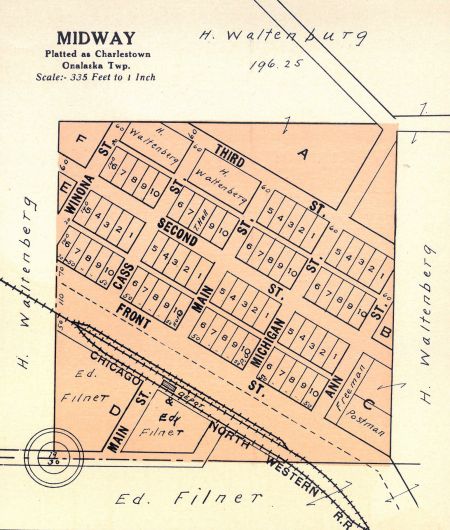
1913 La Crosse County plat map of Midway; note the Chicago & Northwestern railroad through the southern edge of town and the depot building that still stands. A parking lot next to the depot building serves as a convenient entry to the Great River State Trail for walking/biking.
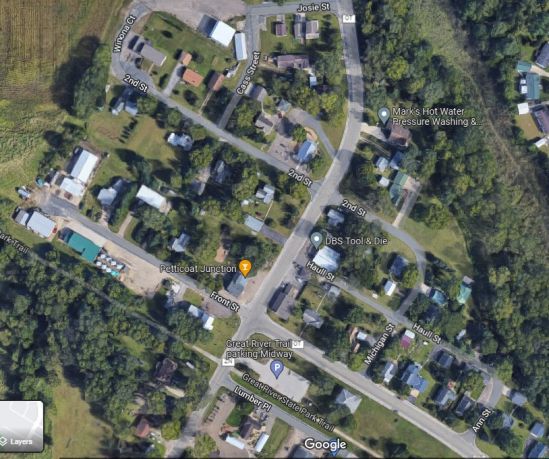
2022 image of Midway from Google Maps; If you comare to 1913 plat map above, you can see that a planned 3rd Street never materialized and Winona Street and Cass Street have been vacated between 2nd Street and Front Street on the west edge of town.
Originally called “Halfway Creek” for the stream nearby of the same name by its founder, J.B. Canterbury, Midway was given its present name when the Chicago & Northwestern railroad was built through the community. It was “midway” between Onalaska and Lytles Station.

Chicago & Northwestern depot in Midway
Canterbury was born in Ireland in 1827 and came to America in 1859, landing in Beaver Dam, Wisconsin. He enlisted in the 5th Wisconsin Volunteer Infantry and served three and half years during the Civil War. He came to the La Crosse area in 1865 and started his grain business in the area that would become Midway, eventually working with the Chicago & Northwestern railroad as a grain buyer.
According to an 1881 La Crosse County History, “Midway Station” contained a “blacksmith-shop, small frame hotel, a store, and an elevator with a capacity of about 10,000 bushels”. Loading pens were also built near the train tracks so that farmers could ship and receive cattle by rail. A post office opened there in 1872 - the same year the C&NW station was established - solidifying itself as a place on the map; the post office stayed in service until 1934.
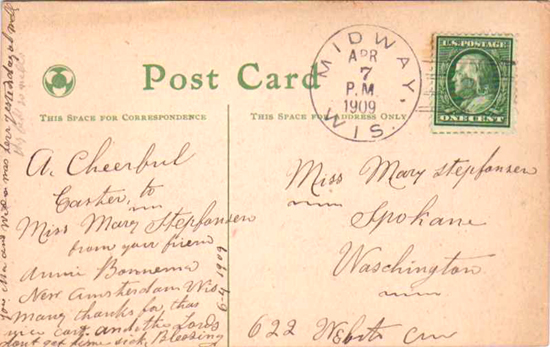
Postcard stamped at Midway post office. Image courtesy of Postalhistory.com
Despite the presence of a major rail line and a U.S. post office, the community of Midway is actually enumerated under the name of “Charleston” in the 1885 Wisconsin State Census, and again in the 1895 census. You may have noticed the note on the 1913 La Crosse County Plat Map image above – “Platted as Charlestown”. Yet, maps and gazetteers from the 1870s and 1880s rightfully all show the location’s name as Midway. So where did the name Charleston/Charlestown come from?
It is possible that it came from the name of a hotel that was located at Midway during this time called the Charleston. This hotel was built in 1878 by Charles W. Nutting, who had settled in the Midway area in 1865. Although no written record could be found, it’s likely the name of the hotel is derived from the builder’s first name. Charles ran the hotel until his death in 1921. His wife, Mary, took over the Charleston until her death in 1924.
One wonders if it was Mr. Nutting who convinced the census-takers that the name of Midway was actually Charleston. Was this done as a joke, or as an exercise in vanity? In both cases, the census-takers certainly should have known the correct name of the village. In 1885 the census-taker was Charles G. Hall, a former chairman and constable of the town of Onalaska. In 1895 the man taking the census was Milo J. Pitkin, the La Crosse County Clerk; one would think that someone in his position would have known the proper names of the communities in the county!
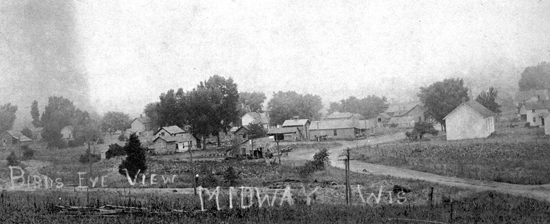
Midway from the book "From Sawmills to Sunfish: a History of Onalaska". Photo credit J. Dolbier
Just outside of Midway along Halfway Creek stood a well-photographed mill, likely originally tied to Midway founder J.B. Canterbury. Later in its history, August Grams took over the mill then known as Morning Star Mills. Grams was one of the earliest residents of La Crosse, coming here from Germany in 1855 at the age of 19. Before leaving Germany, he was taught the trade of miller which he learned with “the scrupulous exactness of an old country artisan”, according to his July 1911 obituary. After spending a few years in Buffalo County in the 1860s-1870s, he returned to Onalaska and bought the mill in 1876.
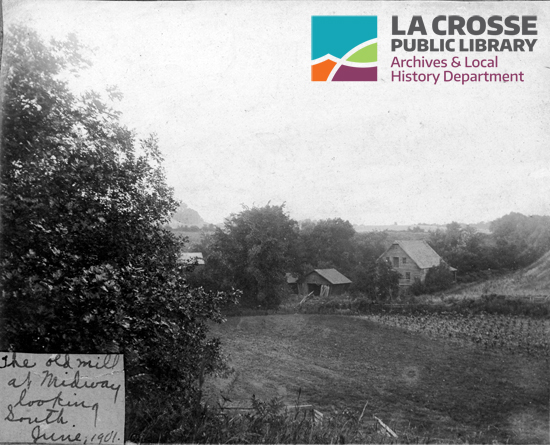
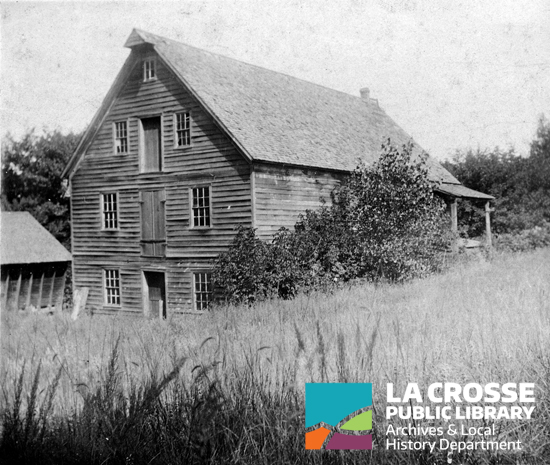
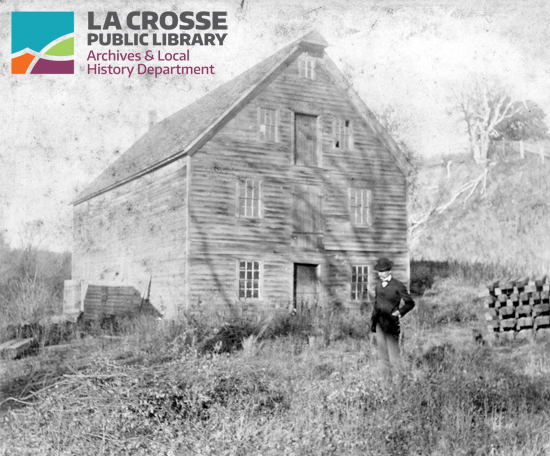
Midway mill photos undated, person unknown
In association with Morning Star Mills in Midway, Grams started a new milling business in downtown La Crosse which bore his name in 1893. A company advertisement for A. Grams & Sons in the 1911 city directory proudly proclaims “proprietors of Morning Star Mills — manufacturers of and dealers in flour, feed, baled hay and straw — buyers of grain — wholesale distributors of the Wingold Flour.”
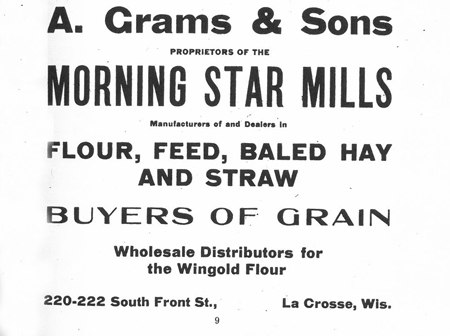
Advertisement from 1911 La Crosse City Directory

This photo was taken near their 218-222 Front Street South location, now the south end of Riverside Park.
Though Midway has always remained an unincorporated community in the Town of Onalaska, it has a rich history of more than 150 years.
